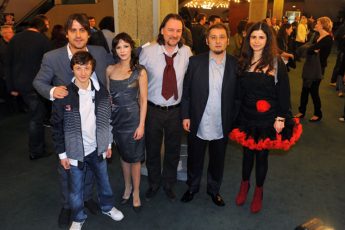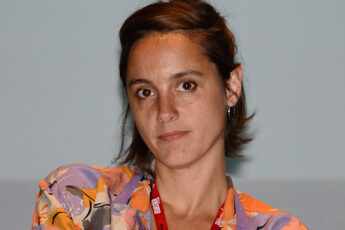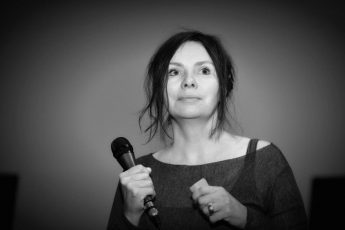Radu Jude on I Do Not Care If We Go Down in History as Barbarians
Vol. 89 (November 2018) by Ana Grgić
We met Radu Jude at the Thessaloniki International Film Festival, where he headed the jury for the event’s main competition. Jude speaks about making his latest film, its theoretical underpinnings, and shooting on celluloid.
You are on this year’s jury at TIFF. How do you like this role – being in the position of judging other films?
I don’t think films should be judged and awarded, but it is a sort of social game and part of the way cinema is constructed – you award some films and do not award others. I hope that the awards can help some films become more visible, in my view that’s the only important aspect of it. I totally dislike the idea which dictates that if a film gets an award, it is good, and if it doesn’t, it is bad.
Your latest film (I Do Not Care If We Go Down in History as Barbarians) is meta-textual and self-reflexive not only in terms of subject matter (the difficult Romanian past and its problematic present) but also in terms of the very act of making films (as a tool for dealing with the past and present). Furthermore, it seems that it is an attempt to address both the Romanian and a collective European responsibility for the past, and in this way raise questions about the racist ideologies of our contemporary times.
My intention was to insert lots of different things into the film. Apart from the main topic, the participation of Romanians in the Holocaust in 1941 and its aftermath, it is also a reflection on what it means to make a film, or more specifically, to make so-called political art. The writer W.G. Sebald had an influence on my film not only in terms of structure but also beyond. I recall that Sebald had described his profession as the questionable business of writing. And I think I understand what he meant. In a way, to make a film is always very questionable. To make a film about history is even more questionable. To make a film about the Holocaust is ten times more questionable. I wanted to raise this issue because I see that most people engaged in political theater, political filmmaking, social art of some kind etc., are 100% convinced that what they’re doing is useful, important, that it changes life, society and so on. I have some concerns about that, which I wanted to highlight with this film.
During the Q&A after the screening, you discussed how the Romanian involvement in the massacre of the Jews, and the country’s being an ally of Nazi Germany during World War 2, was a taboo subject when you were growing up. Furthermore, you mentioned how anti-Semitism still exists in Romania today and that is has surfaced more strongly since 1989. How important was it for you personally to make this film?
Well, personally it is important. Somebody said to me recently “You should go back to making personal films” – my first films dealt with either my personal issues or those of people around me. That person was implying that now I am no longer making personal films. Well, I strongly disagree, because making personal films means making them the way you want them to be, and dealing with the topics that interest you. For me, what’s most important is to make films which can engage others with certain themes, if they’re not already interested in them. I don’t think my film is only about Romania. Of course it is in a way, because it is very local in so many aspects. But I think its essence is everywhere and the risk of different forms of nationalism and fascism is higher than ever in recent years.
On that note, could you please tell us how the film was received in Romania? Has it screened in cinema theaters across the country?
Yes, the distribution started a month ago, and the film did pretty well in terms of audiences. A lot of articles were written about it; some people liked it, while some others in all sorts of media outlets – social media, conventional press, TV and radio – attacked the film. What I found a little bit surprising is that people weren’t necessarily “negationists”, but they considered it a very bad film from an artistic point of view, saying for example “I agree with the topic, but the director doesn’t know how to make a proper film… how can he have one person reading from a book for five minutes, that is totally incompetent.” And so on.
In the witty intellectual exchange scene between theater director Mariana (Ioana Iacob) and City Hall functionary Movila (played by veteran theater director Alexandru Dabija), in which your characters quote Hannah Arendt, Ludwig Wittgenstein, Walter Benjamin and others, you seem to confront the failure of art in addressing a nation’s tragic and complex past. As Movila states: “educating the public is a comical illusion.”
I believe that this pretense that you can make people accept, not educate – as perhaps the verb “educate” is a bit egocentric, signalling superiority -, certain types of artistic directions, means to have people at least be interested in art. When people watch only certain types of cinema, it’s kind of like when people who only have a taste for rock music are transported to a classical music hall. They won’t like it. It happens to myself sometimes. This isn’t because these audiences don’t have musical taste, but because they don’t have a musical education. I think it is really crucial to have people educated in the arts in this sense as much as possible. This is something that isn’t happening at all in Romania. There is no educational culture regarding the arts, not even in the schools. Also, everyone has this feeling that cinema is something that should be easy to understand, and so they label something that they don’t understand as stupid.
The film is interspersed with black comedy and bitter irony. For instance, the non-actors play with uniforms and guns during rehearsals in the national war museum, there are several scenes which desacralize and undermine potent national myths and symbols.
Well, it’s not something conscious, these elements [black comedy and irony] might appear here and there. Maybe it has to do with the way I see the world. Regarding the National Military Museum, my producer Ada Solomon and I struggled a lot to get access to film inside. I wanted to have this secret, hushed story of the massacre and in the background, you see this official patriotic, nationalistic narrative. In many of the shots, I wanted this ‘clash’ of the foreground (the text) and the background (the museum), like a montage inside the image.
The film uses archival footage and photographs in a poignant manner, lingering on these while the characters discuss off screen, which is reminiscent of Godard. How do you work with archives? How can we deal with history through archives?
I’m not sure I can answer this question. Actually, I made a film with archival materials, The Dead Nation (2017), which uses archival footage from research for this film. I have become a lot more interested in working with archival material, because within this footage you can find lots of interesting audio-visual aspects which were not intended when the films were shot. In these images, you can perceive something that was meaningless for the artist at the time, but that is very interesting for us today.
My film [“Barbarians”] is made like a collage, it incorporates different representations of the events which the characters are talking about. I wanted to include different types of representations, so I used photos and archival footage, clips from fiction films such as Sergiu Nicolaescu’s The Mirror (Oglinda, 1993), and quotes from several texts. I wanted the film to be composed from materials which are not all necessarily cinematographic.
A key element I think is the use of footage from the massacres in Lithuania and the simultaneous reflection on the absence of images from the Romanian crimes in Odessa and on the Eastern front.
It’s true. We know what we simultaneously do not know. The image does not exist outside of context. Its meaning is not very clear, and we tend to forget that. Errol Morris, I think, produced a short essay where he put a photographic toy under some rubble made by an explosion, each time placing a different caption under the photo, for example ‘Israeli child toy after bombing’, another ‘Lebanese child toy after bombing’ etc. [Radu Jude is actually referring to the “toy photographers”. Errol Morris interviewed Ben Curtis about these photos. See here.] An image doesn’t necessarily mean something, but it can be used to mean something in different contexts. Somehow in that scene, I wanted to make that point.
The film was shot on Super 16mm film, while the final scene of the military re-enactment, aptly entitled “The Birth of a Nation” (with nods to Griffith), is shot on standard TV equipment. Why did you choose to work on film? And how does this dictate formalistic and stylistic choices in the film?
I wanted to have these differences in the format, so we did some tests and decided that 16mm looks very good. I also wanted it to be obvious that is a film. People are so used to high definition digital images nowadays, and I wanted something with less definition, with grain, a kind of grain that Super 16mm has, which is especially visible on the big screen. That was my intention. In a way with that grain you never forget that you’re watching a film. Also, it’s a format that will soon disappear, so since I was able to, I wanted to use it.
A lot of filmmakers are moving away from film on celluloid, but there are still those who do feel it is important to use film. In an interview some years ago, Corneliu Porumboiu mentioned using film (in Romania) was about the same cost as digital.
Well, it depends on how many takes you’re going to have. I think in our case it was a little bit more expensive but not extremely expensive. For instance, one of my next films will be made using digital. But I want that look because it will be shot in a studio, somehow I want something artificial and very cold.
Can you tell us about your future projects?
Actually, I am working on two films at the same time. The first is an essay-documentary, I’m working on it with a historian who was my consultant, Adrian Cioflâncă. He called me and suggested to do a film using photographs from a massacre which occurred in Iași in 1941, at the start of the war. I said, “I don’t want to make another film about that”, but then he showed me the archival photos he had collected which were very impressive, and I couldn’t refuse, so I said “yes, let’s do the film!” The second project is a kind of adaptation of a play written by Gianina Cărbunariu, a very talented and successful playwright and director, who is making political theater. It is very interesting because it is actually the staging of a Securitate file of a teenager from 1981. So I will make something based on this text. It will be with actors enacting her text, and I will also use archives from the same era, mostly TV footage and studio documentaries. It will be like a clash between two types of history, a small, personal and hidden story from this file, and the official, propagandistic story kept in the National Archives.




Leave a Comment